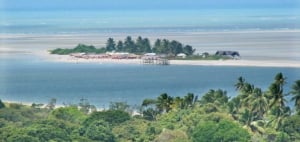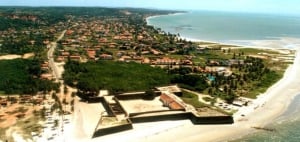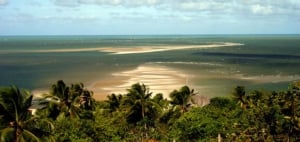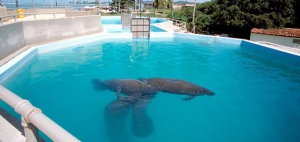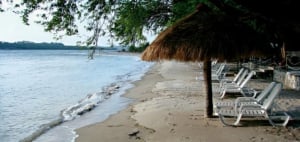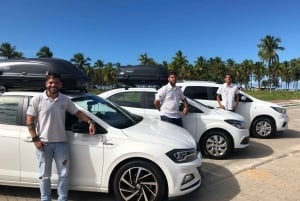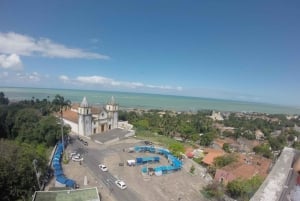The North Coast
The beaches on the North Coast were extremely popular in the State in the past, before the touristic focus shifted to the South Coast. Thus, today the region is less known by foreign tourists, which also means that hotels tend to be smaller and less numerous. Nonetheless, the North Coast is still a great option for a day trip from Recife, where you'll find not only quiet, less crowded beaches, but lots of history from Pernambuco's early days.
In the beginning of Brazil's colonization, its territory was divided in a dozen of large longitudinal strips of land. One of these was called "Itamaracá", stretching from the coast to the edge of the then colony . Today, the name refers solely to an island, located 42 km away from Recife accessible by federal and state highways (or by ferry from the city of Igarassu, going up the river which separates the island from the mainland).
Itamaracá is an important part of Pernambuco's history, not to mention a rewarding visit if you're looking for a quiet beach, inexpensive services and a place to bring the kids. The island's postcard is the Orange Fort: a seventeenth century fortress sitting proud on the beach's white sand, between the waves and palm trees. It was built by the Dutch invaders to protect their recently conquered territory from its Portuguese owners. Inside the Fort, you'll find several handicraft and souvenir shops, plus a museum about its construction, archaeological discoveries on site and the process of its contemporary restoration. Make sure to climb to the top of the wall to see the now idle canons and the stunning view of the ocean (then you'll understand why the Dutch tried so hard to keep this beautiful land to themselves!).
The "Praia do Forte", the beach where the fort is located, is also the most visited one due to the calm, warm waters and good array of services available. From it, you can see an island not too far away, it is the "Coroa do Avião", a sandbank formed by the sea currents and that now has pleasant restaurants and bars, besides an environmental centre for observing bird species. The ferrymen on the beach can take you across quickly, but the question is whether or not you'd like to leave the island afterwards! You might end up having to, since the island is so small there is actually is nowhere to stay.
The "Eco-Parque Peixe-Boi & Cia" is walking distance from the beach and is another place worth a visit, especially if you have kids. It is a centre for rescuing, protecting and restoring manatees to their natural habitat. Visitors can see the lovable marine mammals up close on windowed tanks, plus buy gifts and other articles which help to fund the project.
You can also visit the historical "Vila Velha", the 500 years old village (just off main road from Recife to Itamaracá island) where Pernambuco's first governor in colonial days, Duarte Coelho, arrived from Portugal. The site still has some colonial houses and ruins of a church from the period, not to mentiong a veautiful view over the Santa Cruz canal. The "Pilar" village, on the other hand, is the more urban centre. If you still wish to see more of Pernambuco's colonial history, then don't forget to see in the city of Igarassu the São Cosme e Damião church (the oldest one built in Brazil). Lastly, visitors can go to the Praia do Jaguaribe and, on certain occasions, witness the "Coco de Roda" and "Ciranda", typical dances and rhythms from Pernambuco.
Named after the tiny white crabs that crawl on its sand, the Maria Farinha beach is located 35km from Recife, between the Timbó river and the ocean. It is one of the most beautiful and best preserved beaches in the State, with a large strip of golden sand, plus clear and shallow waters.
Maria Farinha is a popular destination for water sports, such as windsurfing, kayak, jet-skiing and diving. Perhaps even more popular is Veneza Water Park, the largest water park in the State, occupying over 90.000 m². The waterslides, wave pools and many other attractions are enough to keep you busy for a whole day. A mandatory day out, especially if you are travelling with your family.
Our recommendations for Maria Farinha's accomodation options can be viewed here.
In Goiana, the most popular beaches are Ponta de Pedra and Catuama. The waters are warm and protected by natural reefs, though at certain times of the year there can be too much seaweed floating around. Other beaches of this area are Carne de Vaca and Atapuz.
Another interesting option besides the beach is the Ecologic Reserve Aparauá, where visitors can take a hike into the native Atlantic Forest, go on cycling tours and other adventurous sports.
The city of Goiana itself is significant in Pernambuco's historic development, and even today it remains as one of the most important ones in its area. Its historic centre is particularly charming, with many churches and public buildings built in baroque style, including a museum for sacred art. In Goiana you might also find samples of the pottery and ceramic which have made the town famous across the state.
Tambaba is located in the neighbouring State of Paraíba, at a 2 hours drive from Recife (around 120km). It has recently been chosen as one of the top six beaches in the Northeast region (Portal IG, internet survey).
This beach has become quite famous nationally and internationally for one peculiar reason: not particularly because of its sinuous geography, rocky landscape, or abundant vegetation, which complete the Eden-like setting. It is because it is the only Brazilian beach to be declared nudist by a municipal decree.
The non-nudist portion of the beach is separated from the nudist one by a stair, guarded by people who ensure that your clothes only stay on one side of the beach. As it is for other nudist locations, there are strict rules to ensure order and privacy, such as prohibitions of unauthorized filming and photographing, sexual behaviour, and usage or possession of illicit drugs. The management seems to be efficient in enforcing these norms, as Tambaba has held events such as an international congress for nudists in 2008 and nudist surf championships.
On both sides of the beach there are options of hotels, restaurants and ecologic tours in the well preserved native forest.
* Photos by Evaldo Parreira e Rogério Monteiro (EMPETUR), Otavio Nogueira (CC)


